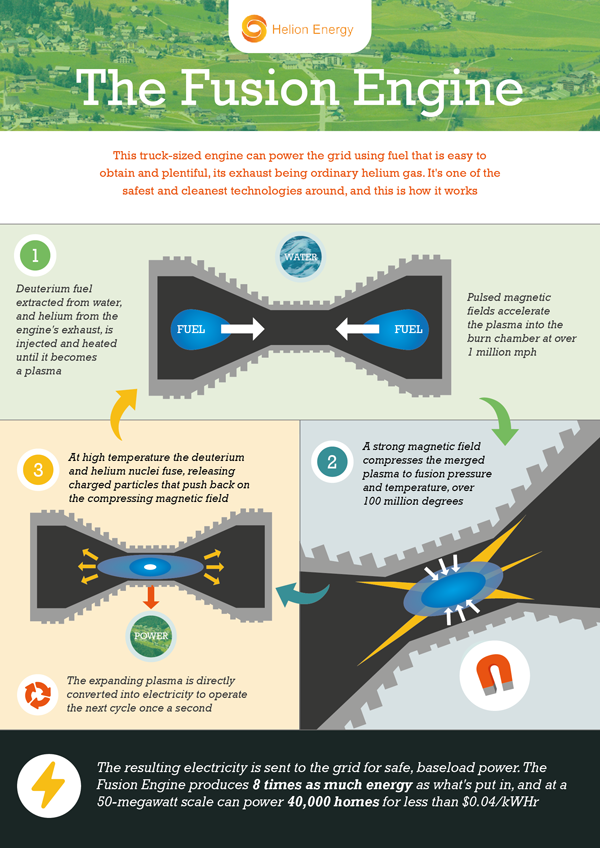I have blogged recently about nuclear fusion as an alternative to nuclear fission for the generation of electricity. There is a huge international fusion research project underway in France called ITER based on the confinement of super hot plasma in a donut shaped configuration called a tokomak. I have blogged about problems they are having with money and management. I have also blogged about universities and companies that are working on smaller and cheaper fusion reactor designs. One of them may be able to construct a commercial prototype fusion power generator before the ITER project is completed. ITER is not even intended to actually generate more power than it consumes for more than a few second. Today, I am going to blog about another entry into the small practical fusion power generator race.
The Helion Fusion Engine is being developed by a trio of institutions. The University of Washington in Seattle is carrying out basic science research on the project. MSNW LLC was created for obtaining grants to develop the technology. Helion Energy was created to commercialize the technology with venture capital.
The Helion Fusion Engineis a new approach that is midway between the steady state confinement of a super hot plasma like the ITER tokomak design and the inertial confinement approach where a pellet of fuel is bombarded with a sphere of laser beams. In the Helion reactor, fuel is injected into a chamber where it is compressed by magnetic fields and fuses. Energy of the expanding cloud of particles that results is converted directly into electricity. The system fuses a batch of fuel about once a second.
One of the selling points for this reactor is the fact that it does not use nor does it produce radioactive isotopes. It also emits no carbon dioxide. The fuel it uses consists of Helium three which is missing a neutron and deuterium which is hydrogen with an extra neutron. Deuterium comprises more than one one-hundreth of one percent of ocean water. Helium will be captured from the exhaust of the reactor and recycled. Fuel will not be a major expense and no significant waste is produced.
Benefits of the Helion fusion reactor from the Helion Energy website:
- Magneto-Inertial Fusion: By combining the stability of steady magnetic fusion and the heating of pulsed inertial fusion, a commercially practical system has been realized that is smaller and lower cost than existing programs.
- Modular, Distributed Power: A container sized, 50 MW module for base load power generation.
- Self-Supplied Helium 3 Fusion: Pulsed, D-He3 fusion simplifies the engineering of a fusion power plant, lowers costs, and is even cleaner than traditional fusion.
- Magnetic Compression: Fuel is compressed and heated purely by magnetic fields operated with modern solid state electronics. This eliminates inefficient, expensive laser, piston, or beam techniques used by other fusion approaches.
- Direct Energy Conversion: Enabled by pulsed operation, efficient direct conversion decreases plant costs and fusion’s engineering challenges.
- Safe: With no possibility of melt-down, or hazardous nuclear waste, fusion does not suffer the drawbacks that make fission an unattractive alternative.
Helion claims that funding of two hundred million dollars would be sufficient for them to build a pilot commercial fifty megawatt power plant by 2019. Then they could go into commercial production by 2022. Helion estimates that its approach will yield commercial nuclear fusion in one tenth the time of the ITER approach and at one thousandth the cost. With five different organizations all working on small economical nuclear fusion reactors, fusion power may finally be an idea whose time has come.
